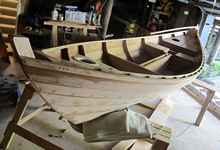
 Custom Search
|
| sails |
| plans |
| epoxy |
| rope/line |
| hardware |
| canoe/kayak |
| sailmaking |
| materials |
| models |
| media |
| tools |
| gear |
| join |
| home |
| indexes |
| classifieds |
| calendar |
| archives |
| about |
| links |
| Join Duckworks Get free newsletter CLICK HERE |
|
|
| Swampscott Dory – Fast, Able and Handsome |
by Miles Quick |
|
It is strange that there aren’t more of these boats around. The designer Pete Culler built two and I found another by searching the internet, but it appears that relatively few were built. There are many other versions of the Swampscott dory to be found, but none as fine as this one I think. I saw a photograph of the original boat in the book Pete Culler on Wooden Boats and wondered if it could be built in plywood, and if so how she’d sail.
That idle thought, on a subject about which I knew nothing, other than owning and occasionally sailing a small dinghy, somehow grew into a resolve to find out. After several years of head-scratching, calculating, cutting, gluing and all the other clumsy activities that constitute amateur boat building, I now have the answer. Initially, it would have been easy to lose heart, but when I discovered that the plans are available from Mystic Seaport Museum my fate was sealed. I ordered the plan and the table of offsets and then, after noticing a similarity between this boat and a lapstrake canoe, I ordered a book by David L Nichols (available on the Duckworks site) called Lapstrake Canoes. I bought several other books, but the technique I finally selected was a slight modification of David’s simple set of instructions. Of course everything had to be much bigger to fit the dory, but the steps remained the same. Before each stage I studied and understood the chapter in David’s book, then I adapted it to the dory and finally I did the work with the book at my side.
I cut the frames, which remain in the boat after construction, from 18 mm plywood. The laminated stem consists of three layers of 18 mm plywood. The bottom is 18 mm plywood and the planks are 6 mm plywood. The standard choice for planks is 9 mm, but I decided on the lighter planks, which I later reinforced with a second laminated layer where necessary. For bulkhead framing I used pine. The plans from Mystic Seaport give enough information to know the shape of each frame, the stem, the transom, and each plank, and I simply adapted David’s method to use the information. There were two things I did differently from the book. The first is that I did not fibreglass the bottom and garboards. If I had I would have planed down to bare plywood for the next plank land, because I don’t trust gluing a plank to cured epoxy. The second thing I did differently was to build a pattern for each plank using light battens and screws, a technique described in Iain Oughtred’s book Clinker Plywood Boatbuilding Manual. David uses a simpler method that didn’t work so well for this boat. It is critical for a good result that the plank lines are perfect. Unfortunately, I don’t have a photograph showing the use of a pattern. This is my daughter helping me to fit the final plank.
The interior of the boat is where I deviated significantly from the original design. It is a nervous moment when you strike out on your own, but over the preceding months I had formulated a strategy to produce a strong boat of absolute simplicity and also accomplish some things not possible with the original design. Simplicity was required to hide my lack of skills. I moved the centreboard back to sit exactly between the frames. This photograph also shows how I strengthened the 6 mm plywood, by cutting to size and gluing an additional layer of plywood for the first 3 planks from the bottom. The extra layer of plywood can be seen butting against the frame.
I added lockers, a motor-well and decking fore and aft.
These internal structures add strength, as does the double oak rail. I devised a simple method by which the rails could end gracefully fore and aft, while also adding strength.
The final structural components are the floorboards, which rest on pine blocks that are glued and screwed to the bottom and bulkheads. The weight of passengers and crew is borne by the bulkheads rather than by the plywood bottom.
The boat was designed for oar and sail, but I have made provision for a small outboard motor. My experience with small boats in rough seas is that when you really need the motor it is near to useless, because it is hanging off a transom that spends most of the time in the air. I have not yet tried it, but I anticipate that a centrally situated motor (in the aft seat) will work well. I intend to build a waterproof case for it, attached by strap alongside the centreboard, so that in an emergency I can recover the boat, strike the rig, insert the motor and get home fast. The floatation chambers are another safety feature. I think the boat will be easy to recover from capsize and the chambers will ensure that I can bail without water coming in the centreboard and motor-well. Another change to the original design is the seating position, which had the helmsman sitting behind the mizzen. I have moved the mizzen back slightly (matching the centreboard, which was also moved), and the helmsman sits in front of the mizzen and has full use of the cockpit. Now that I am sailing the boat I can see that I made the correct decision. A recent change I made is to build a push-pull tiller. This works very well, because you can sit anywhere on the seat facing forwards, or you can sit on the rail. The position feels quite natural in practice. It is only when you sail the boat that you realise how unsuitable a normal tiller is, because in a dory you often move to the middle of the seat to balance the boat. A length of shot-cord from elbow to rail counters the downward swing of the raked rudder.
The mizzen sheet is fed through a plastic hoop on a rope attached to the rudder shaft, then through a guide and cleat on the tiller plywood attachment. It is not very clear, but the guide and cleat are visible as black objects in the photograph, and the plastic hoop can be seen hanging from the rudder by a rope that passes through the rudder shaft. The main sheet is fed through plastic hoops attached by rope to each rail, then to a cleat block located behind the mizzen mast. There are 2 main mast positions, the aft with more rake.
After doing the calculation I realised that the centreboard would have to be bolted close to the top, which moves the centre of resistance forward a few inches. That turned out to be a good thing, because I think it exposes more board area.
I have spent several months testing the boat, and it all works well. She is fast, dry, tracks very straight and handles rough water well. There is no weather helm or lee helm. She quickly reaches hull speed (5 - 5.5 knots according to GPS) on any point of sail, in most conditions, if the wind is 10 knots or more. She is very fast in light wind. When you sheet the mizzen and release the main she sits to wind. I can confirm that if the boat is built in 6 mm plywood, like this one, additional strengthening of the lower planks is necessary, because the bottom is narrow, and you often brace yourself against the planks. The small, loose footed sprit sails (the smaller mizzen has a sprit boom) are very easy to handle. They remain permanently on the mast and sprit, being furled on the sprit and tied to the mast when not in use. In addition to using the single line of reef points on the main, there are several reefing options. I will decide beforehand whether to use the reef points or not, and set that part up on land. Once underway I can use main and mizzen, or raked main (using the aft main position) without mizzen or mizzen alone in the aft main position. Dealing with the rig poses no difficulty, even in a rough sea. This is a very stable boat. There is a single rowing station, and rowing is effortless. I am sure the boat would perform well in certain kinds of adventure race. I gave a lot of thought to the trailer. I previously have had problems retrieving a boat in waves where a wave lifts the boat off the centre roller and drops it elsewhere, resulting in the plywood being gouged. This happened so frequently that I seemed always to be making repairs. I was determined not to let that happen to this boat. The solution was to use wide rollers and bow guides. The rollers in front of and behind the wheels are aligned with frames of the boat, to minimise stress on the boat.
I have recently moved the light-box to permanently attach to the top of the bow guides. There is sufficient space under the light-box in all circumstances. Retrieving the boat in waves is simple. I lift the bow onto the roller, attach the hook then hold the cable tight as I move to the winch, then winch her in. Rigging, unrigging and trailering are very quick and easy with this boat. Everything fits neatly in the boat and the rudder remains attached. If anyone is tempted to build this boat, perhaps for the challenge of doing something a bit different, I can assure them they won’t be disappointed with the final product. She’s a real thoroughbred.
|
|
















